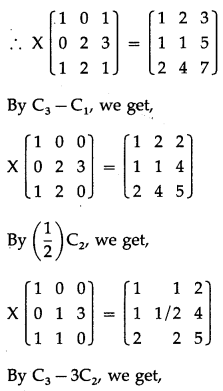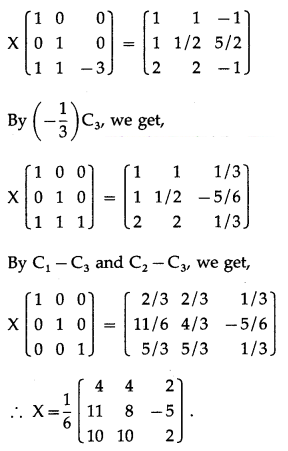Balbharti 12th Maharashtra State Board Maths Solutions Book Pdf Chapter 2 Matrices Miscellaneous Exercise 2A Questions and Answers.
12th Maths Part 1 Matrices Miscellaneous Exercise 2A Questions And Answers Maharashtra Board
Question 1.
If A = \(\left[\begin{array}{lll}
1 & 0 & 0 \\
2 & 1 & 0 \\
3 & 3 & 1
\end{array}\right]\) then reduce it to I
3
by using column transformations.
Solution:
|A| = \(\left|\begin{array}{lll}
1 & 0 & 0 \\
2 & 1 & 0 \\
3 & 3 & 1
\end{array}\right|\)
= 1(1 – 0) – 0 + 0 = 1 ≠ 0
∴ A is a non-singular matrix.
Hence, the required transformation is possible.
Now, A = \(\left[\begin{array}{lll}
1 & 0 & 0 \\
2 & 1 & 0 \\
3 & 3 & 1
\end{array}\right]\)
By C
1
– 2C
2
, we get, A ~ \(\left[\begin{array}{lll}
1 & 0 & 0 \\
0 & 1 & 0 \\
-3 & 3 & 1
\end{array}\right]\)
By C
1
+ 3C
3
and C
2
– 3C
3
, we get,
A ~ \(\left[\begin{array}{lll}
1 & 0 & 0 \\
0 & 1 & 0 \\
0 & 0 & 1
\end{array}\right]\) = I
3
.
Question 2.
If A = \(\left[\begin{array}{lll}
2 & 1 & 3 \\
1 & 0 & 1 \\
1 & 1 & 1
\end{array}\right]\), then reduce it to I
3
by using row transformations.
Solution:
|A| = \(\left|\begin{array}{lll}
2 & 1 & 3 \\
1 & 0 & 1 \\
1 & 1 & 1
\end{array}\right|\)
= 2 (0 – 1) – 1(1 – 1) + 3 (1 – 0)
= -2 – 0 + 3 = 1 ≠ 0
∴ A is a non-singular matrix.
Hence, the required transformation is possible.
Now, A = \(\left[\begin{array}{lll}
2 & 1 & 3 \\
1 & 0 & 1 \\
1 & 1 & 1
\end{array}\right]\)
By R
1
– R
2
, we get,
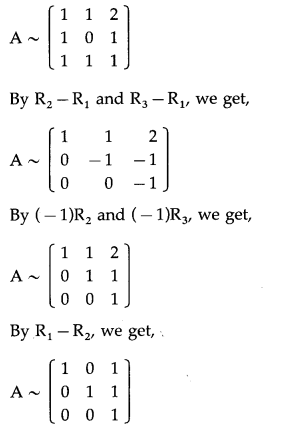
By R
1
– R
3
and By R
2
– R
3
, we get
A ~ \(\left[\begin{array}{lll}
1 & 0 & 0 \\
0 & 1 & 0 \\
0 & 0 & 1
\end{array}\right]\) = I
3
.

Question 3.
Check whether the following matrices are invertible or not:
(i) \(\left[\begin{array}{ll}
1 & 0 \\
0 & 1
\end{array}\right]\)
Solution:
Let A = \(\left[\begin{array}{ll}
1 & 0 \\
0 & 1
\end{array}\right]\)
Then, |A| = \(\left|\begin{array}{ll}
1 & 0 \\
0 & 1
\end{array}\right|\) = 1 – 0 = 1 ≠ 0.
∴ A is a non-singular matrix.
Hence, A
-1
exists.
(ii) \(\left[\begin{array}{ll}
1 & 1 \\
1 & 1
\end{array}\right]\)
Solution:
Let A = \(\left[\begin{array}{ll}
1 & 1 \\
1 & 1
\end{array}\right]\)
Then, |A| = \(\left|\begin{array}{ll}
1 & 1 \\
1 & 1
\end{array}\right|\) = 1 – 1 = 0.
∴ A is a singular matrix.
Hence, A
-1
does not exist.
(iii) \(\left[\begin{array}{ll}
1 & 2 \\
3 & 3
\end{array}\right]\)
Solution:
Let A = \(\left[\begin{array}{ll}
1 & 2 \\
3 & 3
\end{array}\right]\)
Then, |A| = \(\left|\begin{array}{ll}
1 & 2 \\
3 & 3
\end{array}\right|\) = 3 – 6 = -3 ≠ 0.
∴ A is a non-singular matrix.
Hence, A
-1
exist.

(iv) \(\left[\begin{array}{ll}
2 & 3 \\
10 & 15
\end{array}\right]\)
Solution:
Let A = \(\left[\begin{array}{ll}
2 & 3 \\
10 & 15
\end{array}\right]\)
Then, |A| = \(\left|\begin{array}{ll}
2 & 3 \\
10 & 15
\end{array}\right|\) = 30 – 30 = 0.
∴ A is a singular matrix.
Hence, A
-1
does not exist.
(v) \(\left[\begin{array}{rr}
\cos \theta & \sin \theta \\
-\sin \theta & \cos \theta
\end{array}\right]\)
Solution:
Let A = \(\left[\begin{array}{rr}
\cos \theta & \sin \theta \\
-\sin \theta & \cos \theta
\end{array}\right]\)
Then, |A| = \(\left|\begin{array}{cc}
\sec \theta & \tan \theta \\
\tan \theta & \sec \theta
\end{array}\right|\)
= sec
2
θ – tan
2
θ = 1 ≠ 0.
∴ A is a non-singular matrix.
Hence, A
-1
exist.
(vii) \(\left[\begin{array}{lll}
3 & 4 & 3 \\
1 & 1 & 0 \\
1 & 4 & 5
\end{array}\right]\)
Solution:
let A = \(\left[\begin{array}{lll}
3 & 4 & 3 \\
1 & 1 & 0 \\
1 & 4 & 5
\end{array}\right]\)
Then, |A| = \(\left|\begin{array}{lll}
3 & 4 & 3 \\
1 & 1 & 0 \\
1 & 4 & 5
\end{array}\right|\)
= 3(5 – 0) – 4(5 – 0) + 3(4 – 1)
= 15 – 20 + 9 = 4 ≠ 0
∴ A is a non-singular matrix.
Hence, A
-1
exist.

(viii) \(\left[\begin{array}{lll}
1 & 2 & 3 \\
2 & -1 & 3 \\
1 & 2 & 3
\end{array}\right]\)
Solution:
Let A = \(\left[\begin{array}{lll}
1 & 2 & 3 \\
2 & -1 & 3 \\
1 & 2 & 3
\end{array}\right]\)
Then, |A| = \(\left|\begin{array}{lll}
1 & 2 & 3 \\
2 & -1 & 3 \\
1 & 2 & 3
\end{array}\right|\)
= 1 (-3 -6) – 2 (6 – 3) + 3 (4 + 1)
= -9 – 6 + 15 = 0
∴ A is a singular matrix.
Hence, A
-1
does not exist.
(ix) \(\left[\begin{array}{lll}
1 & 2 & 3 \\
3 & 4 & 5 \\
4 & 6 & 8
\end{array}\right]\)
Solution:
Let A = \(\left[\begin{array}{lll}
1 & 2 & 3 \\
3 & 4 & 5 \\
4 & 6 & 8
\end{array}\right]\)
Then, |A| = \(\left|\begin{array}{lll}
1 & 2 & 3 \\
3 & 4 & 5 \\
4 & 6 & 8
\end{array}\right|\)
= 1(32 – 30) – 2(24 – 20) + 3(18 – 16)
= 2 – 8 + 6 = 0
∴ A is a singular matrix.
Hence, A
-1
does not exist.

Question 4.
Find AB, if A = \(\left[\begin{array}{ccc}
1 & 2 & 3 \\
1 & -2 & -3
\end{array}\right]\) and B = \(\left[\begin{array}{cc}
1 & -1 \\
1 & 2 \\
1 & -2
\end{array}\right]\) Examine whether AB has inverse or not.
Solution:
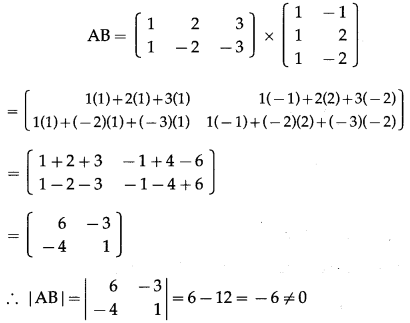
∴ A is a non-singular matrix.
Hence, (AB)
-1
exist.
Question 5.
If A = \(\left[\begin{array}{lll}
x & 0 & 0 \\
0 & y & 0 \\
0 & 0 & z
\end{array}\right]\) is a nonsingular matrix then find A
-1
by elementary row transformations.
Hence, find the inverse of \(\left[\begin{array}{lll}
2 & 0 & 0 \\
0 & 1 & 0 \\
0 & 0 & -1
\end{array}\right]\)
Solution:
Since A is a non-singular matrix, then find A
-1
by using elementary row transformations.
We write AA
-1
= I
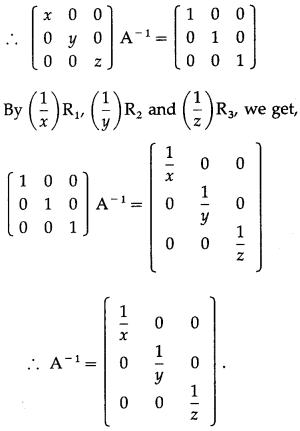
Comparing \(\left[\begin{array}{lll}
2 & 0 & 0 \\
0 & 1 & 0 \\
0 & 0 & -1
\end{array}\right]\) with \(\left[\begin{array}{lll}
x & 0 & 0 \\
0 & y & 0 \\
0 & 0 & z
\end{array}\right]\),
we get, x = 2, y = 1, z = -1
∴ \(\frac{1}{x}\) = \(\frac{1}{2}\), \(\frac{1}{y}\) = \(\frac{1}{1}\) = 1, \(\frac{1}{z}\) = \(\frac{1}{-1}\) = -1
\(\left[\begin{array}{lll}
2 & 0 & 0 \\
0 & 1 & 0 \\
0 & 0 & -1
\end{array}\right]\) is \(\left(\begin{array}{rrr}
\frac{1}{2} & 0 & 0 \\
0 & 1 & 0 \\
0 & 0 & -1
\end{array}\right)\).

Question 6.
if A = \(\left[\begin{array}{ll}
1 & 2 \\
3 & 4
\end{array}\right]\) and X is a 2 × 2 matrix such that AX = I , then find X.
Solution:
We will reduce the matrix A to the identity matrix by using row transformations. During this pro¬cess, I will be converted to the matrix X.
We have AX = I.
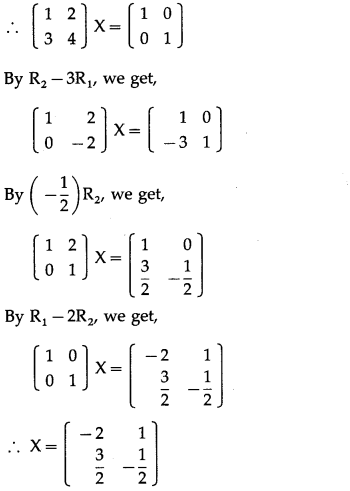
Question 7.
Find the inverse of each of the following matrices (if they exist).
(i) \(\left[\begin{array}{ll}
1 & -1 \\
2 & 3
\end{array}\right]\)
Solution:
Let A = \(\left[\begin{array}{ll}
1 & -1 \\
2 & 3
\end{array}\right]\)
∴ |A| = \(\left|\begin{array}{ll}
1 & -1 \\
2 & 3
\end{array}\right|\) = 3 + 2 = 5 ≠ 0
∴ A
-1
exists.
Consider AA
-1
= I
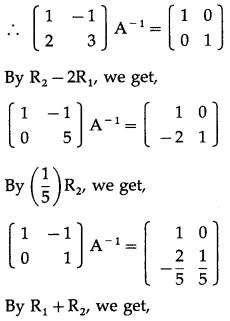
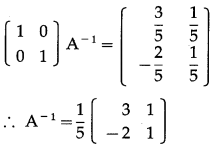
(ii) \(\left[\begin{array}{ll}
2 & 1 \\
1 & -1
\end{array}\right]\)
Solution:
Let A = \(\left[\begin{array}{ll}
2 & 1 \\
1 & -1
\end{array}\right]\)
∴ |A| = \(\left|\begin{array}{ll}
2 & 1 \\
1 & -1
\end{array}\right|\) = -2 – 1 = -3 ≠ 0
∴ A
-1
exists.
Consider AA
-1
= I
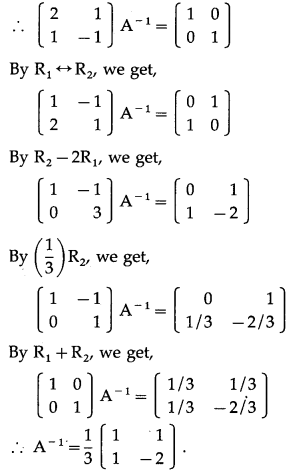

(iii) \(\left[\begin{array}{ll}
1 & 3 \\
2 & 7
\end{array}\right]\)
Solution:
Let A = \(\left[\begin{array}{ll}
1 & 3 \\
2 & 7
\end{array}\right]\)
∴ |A| = \(\left|\begin{array}{ll}
1 & 3 \\
2 & 7
\end{array}\right|\) = 7 – 6 = 1 ≠ 0
∴ A
-1
exists.
Consider AA
-1
= I
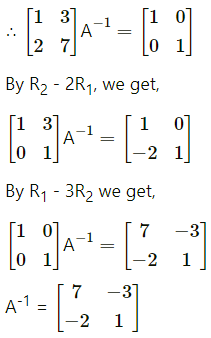
(iv) \(\left[\begin{array}{ll}
2 & -3 \\
5 & 7
\end{array}\right]\)
Solution:
Let A = \(\left[\begin{array}{ll}
2 & -3 \\
5 & 7
\end{array}\right]\)
∴ |A| = \(\left|\begin{array}{ll}
2 & -3 \\
5 & 7
\end{array}\right|\) = 14 + 15 = 29 ≠ 0
∴ A
-1
exists.
Consider AA
-1
= I
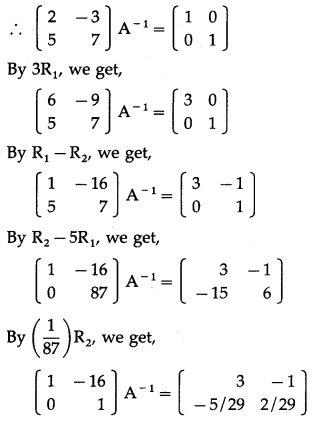
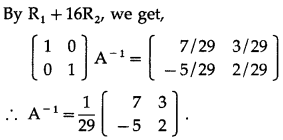

(v) \(\left[\begin{array}{ll}
2 & 1 \\
7 & 4
\end{array}\right]\)
Solution:
Let A = \(\left[\begin{array}{ll}
2 & 1 \\
7 & 4
\end{array}\right]\)
∴ |A| = \(\left|\begin{array}{ll}
2 & 1 \\
7 & 4
\end{array}\right|\) = 8 – 7 = 1 ≠ 0
∴ A
-1
exists.
Consider AA
-1
= I
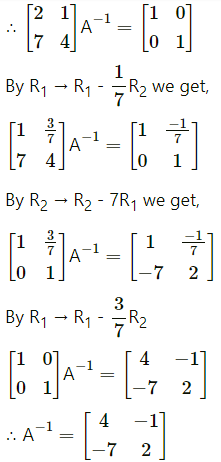
(vi) \(\left[\begin{array}{ll}
3 & -10 \\
2 & -7
\end{array}\right]\)
Solution:
Let A = \(\left[\begin{array}{ll}
3 & -10 \\
2 & -7
\end{array}\right]\)
∴ |A| = \(\left|\begin{array}{ll}
3 & -10 \\
2 & -7
\end{array}\right|\) = -21 + 20 = -1 ≠ 0
∴ A
-1
exists.
Consider AA
-1
= I
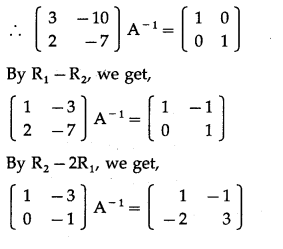
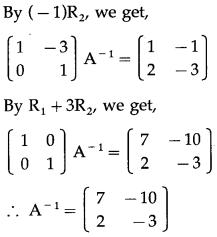

(vii) \(\left[\begin{array}{lll}
2 & -3 & 3 \\
2 & 2 & 3 \\
3 & -2 & 2
\end{array}\right]\)
Solution:
Let A = \(\left[\begin{array}{lll}
2 & -3 & 3 \\
2 & 2 & 3 \\
3 & -2 & 2
\end{array}\right]\)
∴ |A| = \(\left|\begin{array}{lll}
2 & -3 & 3 \\
2 & 2 & 3 \\
3 & -2 & 2
\end{array}\right|\)
= 2(4 + 6) +3(4 – 9) + 3(-4 – 6)
= 20 – 15 – 30 = -25 ≠ 0
∴ A
-1
exists.
Consider AA
-1
= I
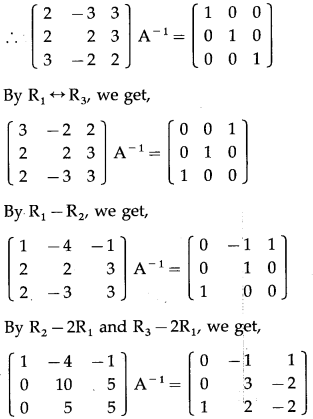
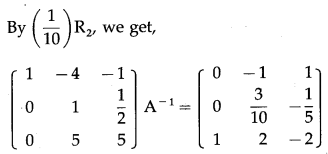
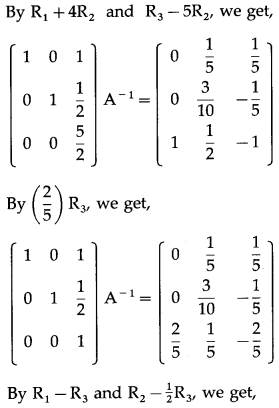
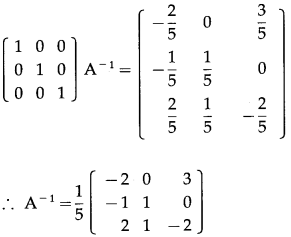
(viii) \(\left[\begin{array}{lll}
1 & 3 & -2 \\
-3 & 0 & -5 \\
2 & 5 & 0
\end{array}\right]\)
Solution:
Let A = \(\left[\begin{array}{lll}
1 & 3 & -2 \\
-3 & 0 & -5 \\
2 & 5 & 0
\end{array}\right]\)
∴ |A| = \(\left|\begin{array}{lll}
1 & 3 & -2 \\
-3 & 0 & -5 \\
2 & 5 & 0
\end{array}\right|\)
= 1(0 + 25) + 3(0 + 10) + 2(-15 – 0)
= 25 + 30 -30
= 25 ≠ 0
∴ A
-1
exists.
Consider AA
-1
= I
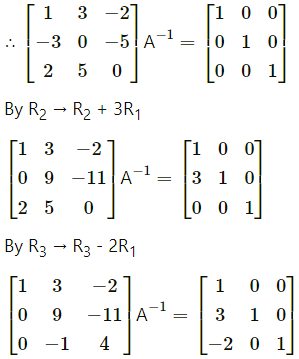
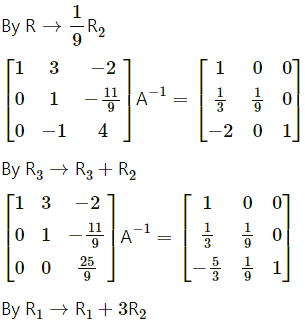
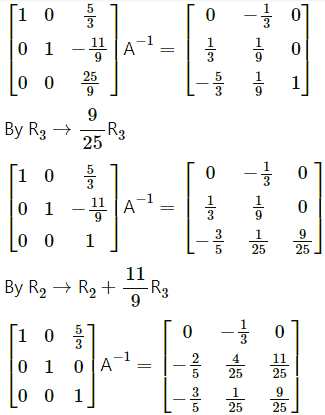
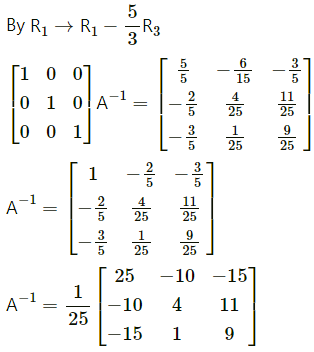
(ix) \(\left[\begin{array}{lll}
2 & 0 & -1 \\
5 & 1 & 0 \\
0 & 1 & 3
\end{array}\right]\)
Solution:
Let A =\(\left[\begin{array}{lll}
2 & 0 & -1 \\
5 & 1 & 0 \\
0 & 1 & 3
\end{array}\right]\)
∴ |A| = \(\left|\begin{array}{lll}
2 & 0 & -1 \\
5 & 1 & 0 \\
0 & 1 & 3
\end{array}\right|\)
= 2(3 – 0) – 0 – 1(5 – 0)
= 6 – 0 – 5 = 1 ≠ 0
∴ A
-1
exists.
Consider AA
-1
= I
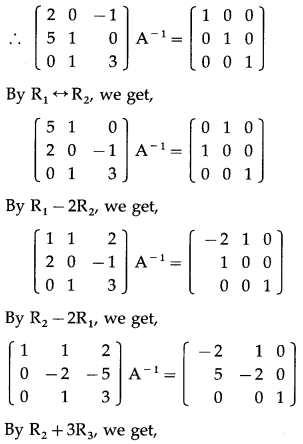
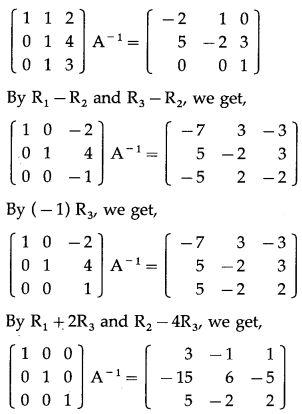
∴ A
-1
= \(\left[\begin{array}{lll}
3 & -1 & 1 \\
-15 & 6 & -5 \\
5 & -2 & 2
\end{array}\right]\)

(x) \(\left[\begin{array}{lll}
1 & 2 & -2 \\
0 & -2 & 1 \\
-1 & 3 & 0
\end{array}\right]\)
Solution:
Let A = \(\left[\begin{array}{lll}
1 & 2 & -2 \\
0 & -2 & 1 \\
-1 & 3 & 0
\end{array}\right]\)
∴ A
-1
= \(\left[\begin{array}{lll}
1 & 2 & -2 \\
0 & -2 & 1 \\
-1 & 3 & 0
\end{array}\right]\)
= 1\(\left|\begin{array}{ll}
-2 & 1 \\
3 & 0
\end{array}\right|\) – 2\(\left|\begin{array}{ll}
0 & 1 \\
-1 & 1
\end{array}\right|\) – 2\(\left|\begin{array}{ll}
0 & -2 \\
-1 & 3
\end{array}\right|\)
|A| = 1(0 – 3) – 2(0 + 1) – 2(0 – 2)
= -3 – 2 + 4
= -1 ≠ 0
∴ A
-1
exists.
We have
AA
-1
= I
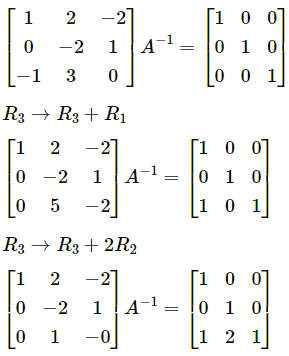
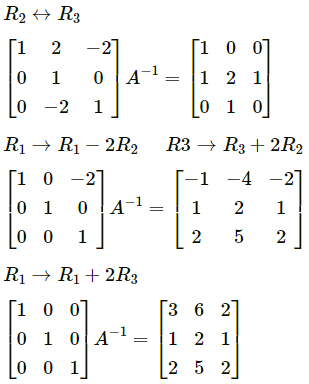
∴ A
-1
= \(\left[\begin{array}{lll}
3 & 6 & 2 \\
1 & 2 & 1 \\
2 & 5 & 2
\end{array}\right]\)
Question 8.
Find the inverse of A = \(\left[\begin{array}{ccc}
\cos \theta & -\sin \theta & 0 \\
\sin \theta & \cos \theta & 0 \\
0 & 0 & 1
\end{array}\right]\) by
(i) elementary row transformations
Solution:
|A| = \(\left|\begin{array}{ccc}
\cos \theta & -\sin \theta & 0 \\
\sin \theta & \cos \theta & 0 \\
0 & 0 & 1
\end{array}\right|\)
= cosθ (cosθ – 0) + sinθ (sinθ – 0) + 0
= cos
2
θ + sin
2
θ = 1 ≠ 0
∴ A
-1
exists.
(i) Consider AA
-1
= I
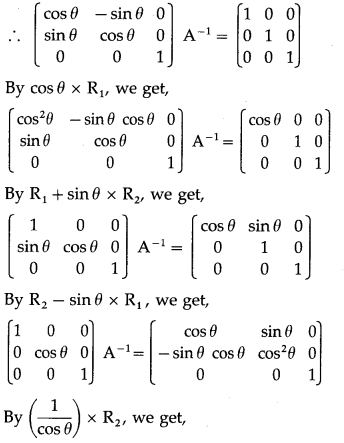
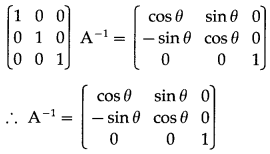

(ii) elementary column transformations
Solution:
Consider A
-1
A = I
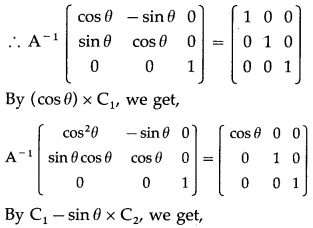
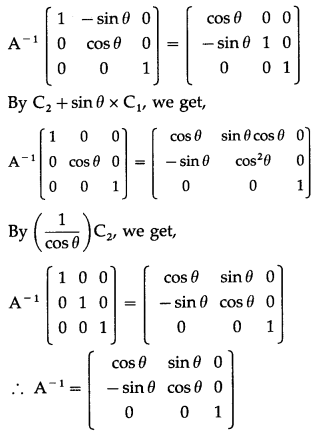
Question 9.
If A = \(\left[\begin{array}{ll}
2 & 3 \\
1 & 2
\end{array}\right]\), B = \(\left[\begin{array}{ll}
1 & 0 \\
3 & 1
\end{array}\right]\) find AB and (AB)
-1
. Verify that (AB)
-1
= B
-1
A
-1
Solution:
AB = \(\left[\begin{array}{ll}
2 & 3 \\
1 & 2
\end{array}\right]\) \(\left[\begin{array}{ll}
1 & 0 \\
3 & 1
\end{array}\right]\)
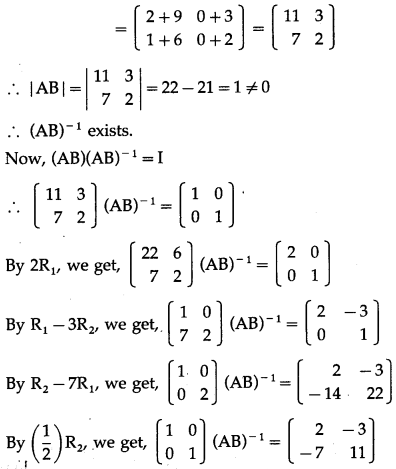
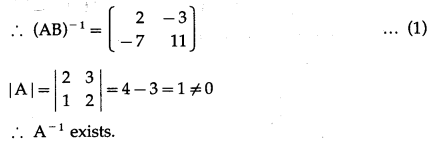
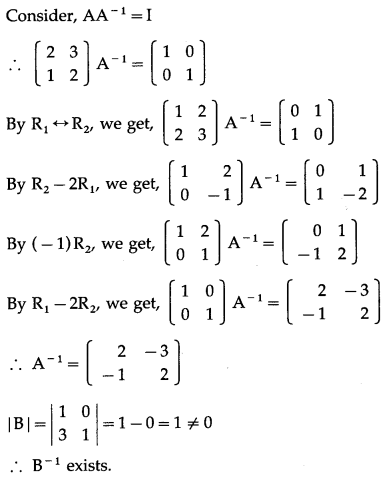
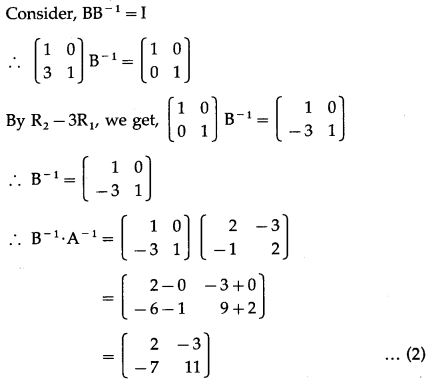
From (1) and (2), (AB)
-1
= B
-1
∙ A
-1
.
Question 10.
If A = \(\left[\begin{array}{ll}
4 & 5 \\
2 & 1
\end{array}\right]\), then show that A
-1
= \(\frac{1}{6}\)(A – 5I)
Solution:
|A| = \(\left|\begin{array}{ll}
4 & 5 \\
2 & 1
\end{array}\right|\) = 4 – 10 = -6 ≠ 0
∴ A
-1
exists.
Consider AA
-1
= I
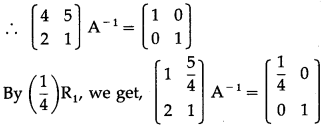
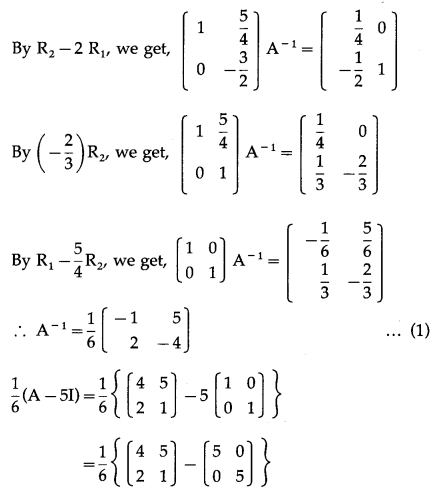


Question 11.
Find matrix X such that AX = B, where A = \(\left[\begin{array}{ll}
1 & 2 \\
-1 & 3
\end{array}\right]\) and B = \(\left[\begin{array}{ll}
0 & 1 \\
2 & 4
\end{array}\right]\)
Solution:
AX = B
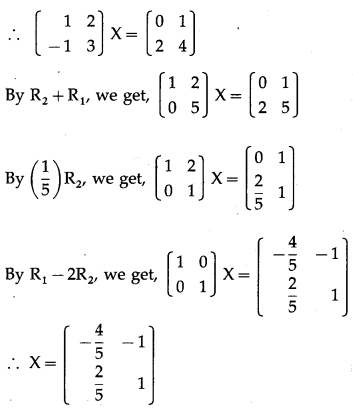
Question 12.
Find X, if AX = B where A = \(\left[\begin{array}{lll}
1 & 2 & 3 \\
-1 & 1 & 2 \\
1 & 2 & 4
\end{array}\right]\) and B = \(\left[\begin{array}{l}
1 \\
2 \\
3
\end{array}\right]\).
Solution:
AX = B
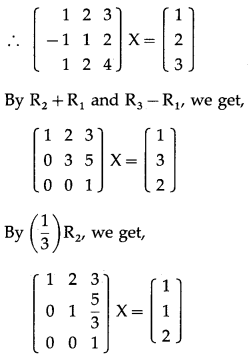
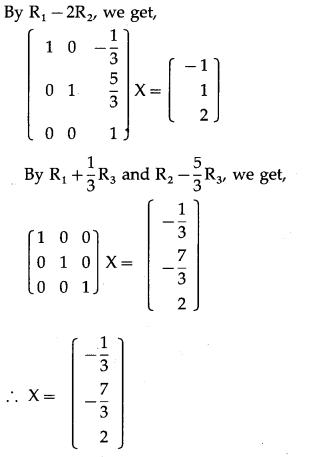
Question 13.
If A = \(\left[\begin{array}{ll}
1 & 1 \\
1 & 2
\end{array}\right]\), B = \(\left[\begin{array}{ll}
4 & 1 \\
3 & 1
\end{array}\right]\) and C = \(\left[\begin{array}{ll}
24 & 7 \\
31 & 9
\end{array}\right]\) then find matrix X such that AXB = C.
Solution:
AXB = C
∴ \(\left(\begin{array}{ll}
1 & 1 \\
1 & 2
\end{array}\right)(\mathrm{XB})\) =\(\left[\begin{array}{ll}
24 & 7 \\
31 & 9
\end{array}\right]\)
First we perform the row transformations.
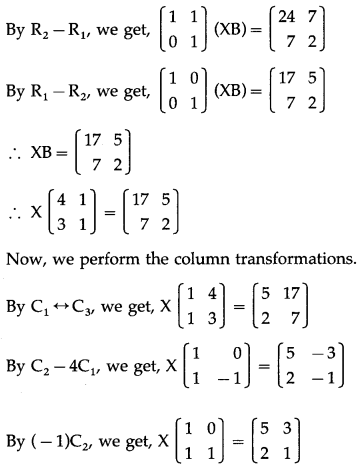
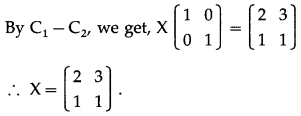

Question 14.
Find the inverse of \(\left[\begin{array}{lll}
1 & 2 & 3 \\
1 & 1 & 5 \\
2 & 4 & 7
\end{array}\right]\) by adjoint method.
Solution:
Let A = \(\left[\begin{array}{lll}
1 & 2 & 3 \\
1 & 1 & 5 \\
2 & 4 & 7
\end{array}\right]\)
∴ |A| = \(\left|\begin{array}{lll}
1 & 2 & 3 \\
1 & 1 & 5 \\
2 & 4 & 7
\end{array}\right|\)
= 1(7 – 20) – 2(7 – 10) + 3(4 – 2)
= -13 + 6 + 6 = -1 ≠ 0
∴ A
-1
exists.
First we have to find the cofactor matrix
= [A
ij
]
3×3
where A
ij
= (-1)
i+j
M
ij
Now, A
11
= (-1)
1+1
M
11
= \(\left|\begin{array}{ll}
1 & 5 \\
4 & 7
\end{array}\right|\) = 7 – 20 = -13
A
12
= (-1)
1+2
M
12
= \(\left|\begin{array}{ll}
1 & 5 \\
2 & 7
\end{array}\right|\) = -(7 – 10) = 3
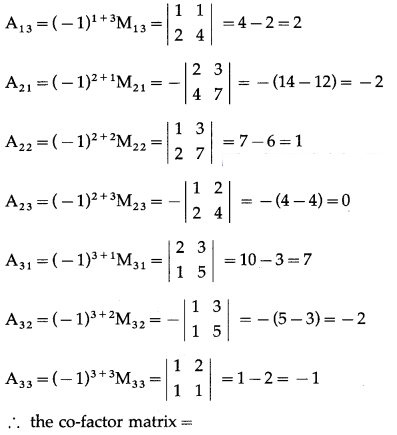
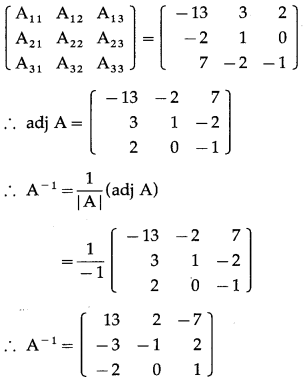
Question 15.
Find the inverse of \(\left[\begin{array}{lll}
1 & 0 & 1 \\
0 & 2 & 3 \\
1 & 2 & 1
\end{array}\right]\) by adjoint method.
Solution:
where A = \(\left[\begin{array}{lll}
1 & 0 & 1 \\
0 & 2 & 3 \\
1 & 2 & 1
\end{array}\right]\)
|A| = 1(2 – 6) – 0(0 – 3) + 1(0 – 2)
|A| = -4 – 2
|A| = -6 ≠ 0
∴ A
-1
exists.
First we have to find the cofactor matrix
= [A
ij
]3×3, where A
ij
= (-1)
i+j
M
ij
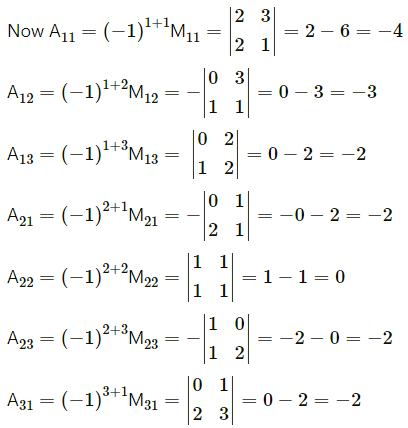
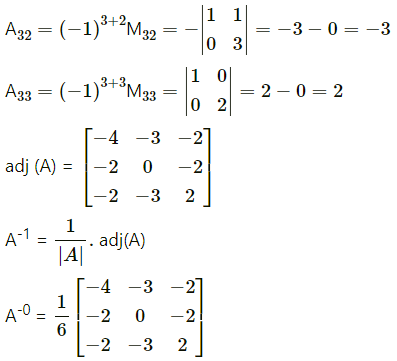

Question 16.
Find A
-1
by adjoint method and by elementary transformations if A = \(\left[\begin{array}{lll}
1 & 2 & 3 \\
-1 & 1 & 2 \\
1 & 2 & 4
\end{array}\right]\)
Solution:
|A| = \(\left|\begin{array}{lll}
1 & 2 & 3 \\
-1 & 1 & 2 \\
1 & 2 & 4
\end{array}\right|\)
= 1(4 – 4) – 2(-4 – 2) + 3(-2 – 1)
= 0 + 12 – 9 = 3 ≠ 0
∴ A
-1
exists.
A
-1
by adjoint method :
We have to find the cofactor matrix
= [A
ij
]
3×3
, where A
ij
= (-1)
i+j
M
ij
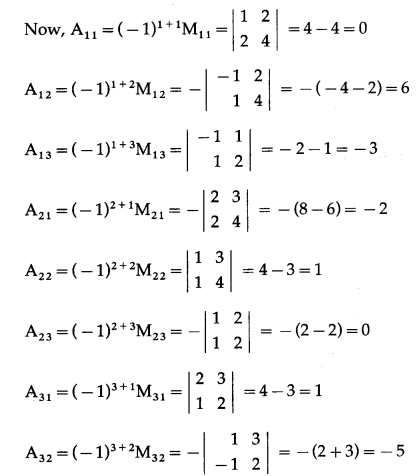
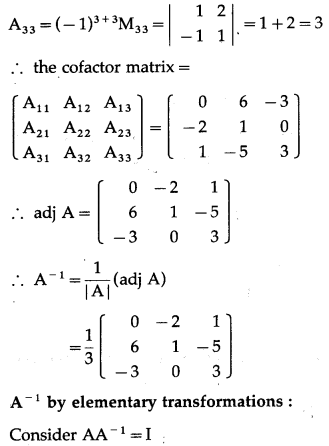
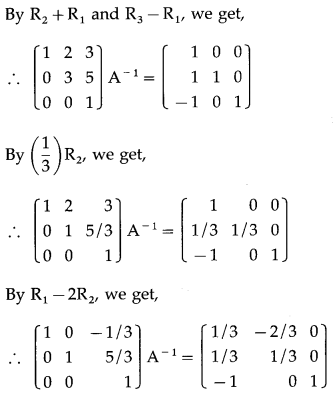
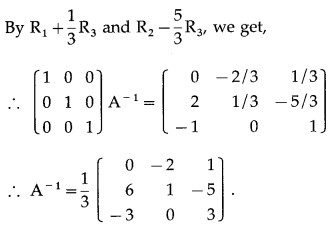
Question 17.
Find the inverse of A = \(\left[\begin{array}{lll}
1 & 0 & 1 \\
0 & 2 & 3 \\
1 & 2 & 1
\end{array}\right]\) by elementary column transformations.
Solution:
|A| = \(\left|\begin{array}{lll}
1 & 0 & 1 \\
0 & 2 & 3 \\
1 & 2 & 1
\end{array}\right|\)
= 1 (2 – 6) – 0 + 1 (0 – 2)
= -4 – 2= -6 ≠ 0
∴ A
-1
exists.
Consider A
-1
A = I
∴ A
-1
\(\left[\begin{array}{lll}
1 & 0 & 1 \\
0 & 2 & 3 \\
1 & 2 & 1
\end{array}\right]\) = \(\left[\begin{array}{lll}
1 & 0 & 0 \\
0 & 1 & 0 \\
0 & 0 & 1
\end{array}\right]\)
By C
3
– C
1
, we get,
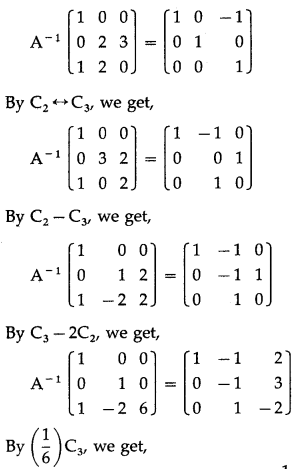
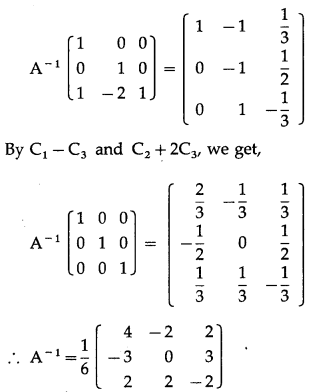

Question 18.
Find the inverse of \(\left[\begin{array}{lll}
1 & 2 & 3 \\
1 & 1 & 5 \\
2 & 4 & 7
\end{array}\right]\) by elementary row transformations.
Solution:
Let A = \(\left[\begin{array}{lll}
1 & 2 & 3 \\
1 & 1 & 5 \\
2 & 4 & 7
\end{array}\right]\)
∴ |A| = \(\left|\begin{array}{lll}
1 & 2 & 3 \\
1 & 1 & 5 \\
2 & 4 & 7
\end{array}\right|\)
= 1(7 – 20) – 2(7 – 10) + 3(4 – 2)
= -13 + 6 + 6 = -1 ≠ 0
∴ A
-1
exists.
Consider AA
-1
= I
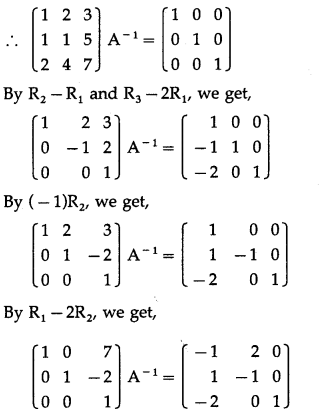
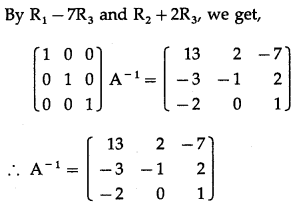
Question 19.
Show with usual notations that for any matrix A = [a
ij
]
3×3
(i) a
11
A
21
+ a
12
A
22
+ a
13
A
23
= 0
Solution:
A = [a
ij
]
3×3
= \(\left[\begin{array}{lll}
a_{11} & a_{12} & a_{13} \\
a_{21} & a_{22} & a_{23} \\
a_{31} & a_{32} & a_{33}
\end{array}\right]\)
(i) A
21
= (-1)
2+1
M
21
= \(-\left|\begin{array}{ll}
a_{12} & a_{13} \\
a_{32} & a_{33}
\end{array}\right|\)
= -(a
12
a
33
– a
13
a
32
)
= -a
12
a
33
+ a
13
a
32
A
22
= (-1)
2+2
M
22
= \(\left|\begin{array}{ll}
a_{11} & a_{13} \\
a_{31} & a_{33}
\end{array}\right|\)
= a
11
a
33
– a
13
a
31
A
23
= (-1)
2+3
M
23
= \(-\left|\begin{array}{ll}
a_{11} & a_{12} \\
a_{31} & a_{32}
\end{array}\right|\)
= -(a
11
a
32
– a
12
a
31
)
= -a
11
a
32
+ a
12
a
31
∴ a
11
A
21
+ a
12
A
22
+ a
13
A
23
= a
11
(-a
12
33
+ a
13
a
32
) + a
12
(a
11
a
33
– a
13
a
31
) + a
13
(-a
11
a
32
+ a
12
a
31
)
= -a
11
a
12
a
33
+ a
11
a
13
a
32
+ a
11
a
12
a
33
– a
12
a
13
a
31
– a
11
a
13
a
32
+ a
12
a
13
a
31
= 0

(ii) a
11
A
11
+ a
12
A
12
+ a
13
A
13
= |A|
Solution:
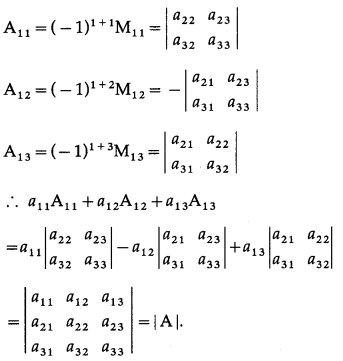
Question 20.
If A = \(\left[\begin{array}{lll}
1 & 0 & 1 \\
0 & 2 & 3 \\
1 & 2 & 1
\end{array}\right]\) and B = \(\left[\begin{array}{lll}
1 & 2 & 3 \\
1 & 1 & 5 \\
2 & 4 & 7
\end{array}\right]\), then find a matrix X such that XA= B.
Solution:
Consider XA = B
